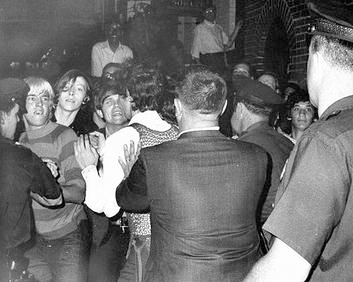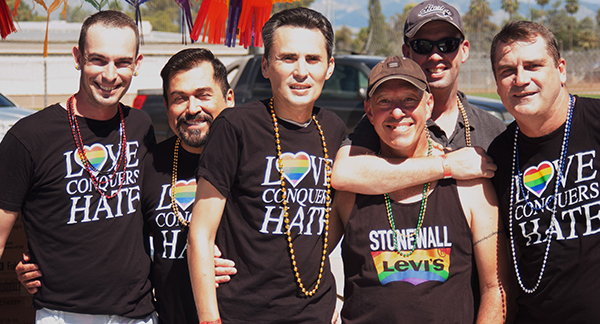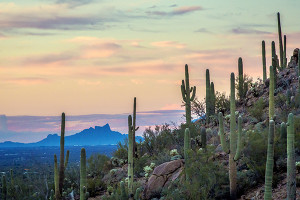Community
Rise Up!
Pride in the Desert Pays Tribute to the 50th Anniversary of Stonewall

On September 28, Tucson Pride is bringing together the LGBTQIA+ community and allies for a family-friendly day of fun, music, dance, and celebration during the Tucson Pride in the Desert festivities. Replete with the annual parade starting at 11 a.m. and a festival from noon to 9 p.m., Pride in the Desert involves balancing light-hearted jubilation with commemoration, reflection, and mobilization.
“Ultimately, ‘Rise Up!’ is a call to action in our community,” explains Tucson Pride President Sam Cloud over email. “We have made vast progress over 50 years, but there is still so much work to do and we look towards the next generation to rise up and continue the efforts of those who paved the way before us.”
 The 50-year landmark Cloud refers to is the 1969 Stonewall Riots in New York City’s Greenwich Village, which began in the early morning of Saturday, June 28 when police attempted – yet another – raid on the Stonewall Inn’s clientele. The patrons fought back, organized, and the queer community has been fighting for equal civil rights ever since.
The 50-year landmark Cloud refers to is the 1969 Stonewall Riots in New York City’s Greenwich Village, which began in the early morning of Saturday, June 28 when police attempted – yet another – raid on the Stonewall Inn’s clientele. The patrons fought back, organized, and the queer community has been fighting for equal civil rights ever since.
Locally, the LGBTQIA+ community had its own Stonewall seven years later. According to TucsonPride.org, the “Tucson Pride history began with a different tragedy; the brutal murder of Richard Heakin, a young gay man leaving the Stonewall Tavern here in Tucson one evening in 1976. When his attackers were given a slap on the wrist, our community rose UNITED to rally for change, officially forming the organization now known as Tucson Pride. Their efforts led to some of the first LGBT anti-discrimination legislation in the country.”
 For the last 42 years, pride events have been held annually – starting at Himmel Park in 1977 with a handful of community members in attendance. Now, it is a large-scale fete that hosts over 4,000 event-goers flocking to Reid Park to enjoy the parade, activities for all-ages – including a Kid Zone, two stages of entertainment, along with loads of vendors and community resources set up throughout the event area.
For the last 42 years, pride events have been held annually – starting at Himmel Park in 1977 with a handful of community members in attendance. Now, it is a large-scale fete that hosts over 4,000 event-goers flocking to Reid Park to enjoy the parade, activities for all-ages – including a Kid Zone, two stages of entertainment, along with loads of vendors and community resources set up throughout the event area.
“It takes a village to put on both the parade and festival,” Cloud shares, laying out the impressive details of producing an event that costs $70,000. The nonprofit’s board of directors navigates numerous local and state governmental agencies such as Parks and Recreation and the Tucson Police and Fire departments, coordinates 150 volunteers, collaborates with over 100 sponsors and vendors, works with other Pride organizations, books entertainment with local and national talent, diligently fundraises, and manages all the logistics that ensure event goers are happy and comfortable.
“We’ve addressed feedback from the community last year related to the festival and how we can improve the experience for all,” Cloud details. “We’ve added cooling tents, free water, more diversity, LGBTQ history, and we’ve implemented new processes to reduce admission line wait times.”
Those hospitality aspects will enhance the enjoyment of the entertainment at Reid Park’s DeMeester Outdoor Performance Center. The main stage headliners include Esera Tuaolo, Brody Ray, and Debby Holiday. Headlining the community and dance tent are DJ Tega, DJ Remix, and DJ Shorty.

Debby Holiday headlines the main stage at Tucson Pride in the Desert festival on Sat, Sept 28. Photo courtesy Tucson Pride
In addition to live music, Tucson Pride’s Tucson Queerstory R*Evolution committee will have a historic walk through the festival grounds highlighting notable moments in local LGBTQIA+ history, as well as displaying memorabilia and video, and collecting personal stories from attendees for a video archive.
Along with supporting, celebrating, and fostering understanding of a diverse queer community, the focus of Pride in the Desert is firmly rooted in promoting the visibility of the LGBTQIA+ people and the ongoing work for equal rights.
“Visibility is crucial, now more than ever.” Cloud elucidates: “There is a large portion of the population that believes since our community now has the ability to marry same sex partners that we have achieved equal rights. This is far from the truth! Rights of people identifying as transgender have been ripped away from them. We still do not have full protection under the law to be free from employment discrimination, housing discrimination, businesses can still refuse service to us (remember the wedding cake bakery controversy?).
that we have achieved equal rights. This is far from the truth! Rights of people identifying as transgender have been ripped away from them. We still do not have full protection under the law to be free from employment discrimination, housing discrimination, businesses can still refuse service to us (remember the wedding cake bakery controversy?).
“Locally, one of the key issues happening right now is the ongoing debate over TUSD’s proposed new inclusive, age-appropriate and scientifically based sex education curriculum.”
According to an Arizona Public Media story published in late August, TUSD’s “curriculum is controversial because it moves beyond sexual abstinence as the only effective way of preventing unwanted pregnancies and sexually transmitted diseases. The updated proposal also takes a more gender-neutral position toward LGBT students, removing language they might find offensive.” The Tucson Unified School District board will vote on updating the sex education curriculum on September 10.
In an August 22, 2019 KVOA Channel 4 interview on the TUSD sex education updates, Cloud eloquently states, “Education and knowledge is power. That’s how we change things, and to limit children from education that could very well save their lives someday is abhorrent. We cannot do that. Children deserve better. The next generation deserves better.”
The next generation does deserve better. For the progress made over the last five decades (see below for landmark events), the fact that violent hate crimes perpetuated against the queer community still happen and that Safe Spaces are set up at local businesses to assist victims of hate crimes is telling.
“We’re people too,” Cloud said in an August 21 KVOA Channel 4 interview. “We’re just like everyone else, we have families, we have jobs, we deserve the same rights and we deserve to not live in fear.”
The Pride parade is free to spectators, starts at 11 a.m., and wends from Country Club Road and Broadway Boulevard to Reid Park at South Concert Place Way. To participate in the parade, there are nominal fees based on the entry type. The deadline to enter is Sept. 14. Email parade@tucsonpride.org for entry details and costs. General admission tickets for the festival are $20, with various discounts offered. Visit TucsonPride.org/pride2019 for all of the information.
Landmark Events in the LGBTQIA+ Human Rights Movement since Stonewall*
June 28, 1969: The Stonewall Riots put the LGBT movement on the mainstream map due to the size and media publicity.
December 1973: The American Psychiatric Association removes homosexuality as a “diagnosis” from the second edition of its Diagnostic and Statistical Manual (DSM).
May 20, 1996: Supreme Court of the United States (SCOTUS) rules a Colorado state constitutional amendment preventing protected status based upon homosexuality or bisexuality goes against the U.S. Constitution’s 14th Amendment Equal Protection Clause in Romer v. Evans.
June 26, 2003: In Lawrence v. Texas, SCOTUS rules that laws prohibiting private homosexual activity between consenting adults are unconstitutional and violate the U.S. Constitution’s 14th Amendment Due Process Clause.
October 2009: The Matthew Shepard & James Byrd Jr. Hate Crimes Prevention Act becomes U.S. law, expanding the 1969 United States federal hate-crime law to include crimes motivated by a victim’s actual or perceived gender, sexual orientation, gender identity, or disability.
September 20, 2011: Don’t Ask, Don’t Tell Repeal Act of 2010 is implemented, “allowing” gay, lesbian, and bisexual people to serve openly in the U.S. Armed Forces. (It did not establish a non-discrimination policy.)
December 2012: The U.S. Equal Employment Opportunity Commission (EEOC) adopts a Strategic Enforcement Plan that includes “coverage of lesbian, gay, bisexual and transgender individuals under the Civil Rights Act of 1964’s Title VII sex discrimination provisions, as they may apply” as a top Commission enforcement priority.
June 26, 2013: SCOTUS strikes down the Defense of Marriage Act (DOMA) in United States v. Windsor, ruling that DOMA’s denial of federal recognition of same-sex marriages violates the U.S. Constitution’s 5th Amendment Due Process Clause.
January 2015: President Obama acknowledges the LGBTQ community in the State of the Union address. For the first time in U.S. history, the words lesbian, bisexual, and transgender were used in the president’s State of the Union address, when President Obama mentioned that, as Americans, we “respect human dignity” and condemn the persecution of minority groups.
April 2015: President Obama calls for end to conversion therapy. (Note that the link to the WhiteHouse.gov website referenced in the article, along with the petition, lead to a dead link on WhiteHouse.gov.)
June 2015: Sexual orientation is added to the U.S. Armed Forces’ anti-discrimination policy.
June 26, 2015: Love wins! SCOTUS rules in Obergefell v. Hodges that marriage is a fundamental right guaranteed by the U.S. Constitution’s 14th Amendment Equal Protection and Due Process Clauses. This decision also enables married, same-sex couples to adopt children.
July 15, 2015: The U.S. EEOC rules that discrimination based on sexual orientation is covered by the Civil Rights Act of 1964’s Title VII prohibition on sex discrimination in the workplace.
July 23, 2015: The Equality Act is introduced in the U.S. Congress to amend Title VII to extend protection against sexual orientation and gender identity discrimination.
June 24, 2016: The Stonewall National Monument is officially designated by President Obama, becoming the first U.S. National Monument designated as a historic LGBT site.
June 30, 2016: U.S. Military bans on transgender people serving in the armed forces are repealed. (However, on January 22, 2019, SCOTUS allowed Trump’s March 2018 ban on transgender people serving in the U.S. Armed Forces to take effect.)
November 2018: LGBTQ candidates sweep the U.S. midterm elections. More than 150 LGBTQ candidates are elected into local, state, and national offices, putting a historic number of queer or transgender politicians in positions of power.
May 2019: Just ahead of Pride 2019, New York City announced it will erect a monument in Greenwich Village dedicated to Marsha P. Johnson and Sylvia Rivera, activists who played critical roles in both the Stonewall Riots and the NYC queer scene. The two started Street Transvestite Action Revolutionaries (S.T.A.R.) in 1970, an organization dedicated to helping LGBTQ people experiencing homelessness.
*The United States has no federal law prohibiting discrimination nationwide other than from federal executive orders which have a more limited scope than from protections through federal legislation. This list of dates is certainly not exhaustive.
These dates were outlined by – with a huge thanks to – Tucson Pride President Sam Cloud, along with some additions by this author.
Interstate 11: A Road to Nowhere

Saguaro National Park West, looking into Avra Valley
Break out a map of the United States. Start at the Canadian border, at the Michigan town of Port Huron. Trace your finger through Flint and Lansing and down to Indianapolis. Arc southwestward through Paducah, Kentucky, to Memphis, then cross the Big Muddy near Greenville, Mississippi, and barrel down to Texarkana, Houston, and on to the Mexican border at Laredo and Brownsville.
You have just described what has been slugged Interstate 69, the so-called NAFTA Highway. It was approved way back when that trade agreement was first signed, with plans costing upwards of $2.5 billion. So far only segments have been built, since the federal government has been slack on infrastructure since the days of the Great Recession, and the current administration hates the very notion of trade agreements in the first place. About the only place where much activity is taking place is Texas, where, for the past decade, sections of the highway have been laid out and others constructed using funds from tolls, public-private partnerships, and fees imposed on commercial vehicles.
Now focus on Arizona. Draw a line from Nogales to just north of Green Valley. Jog to the west through the Avra Valley behind the Tucson Mountains. Follow a line roughly parallel to the existing Interstate 10 up to Casa Grande, then jog west again through the Maricopa Mountains to Buckeye. Go west more, across the wetlands of the Gila and Hassayampa Rivers, and follow Aguila Road and the Vulture Mine Road up to Wickenburg.
You have just described the southern reach of what has been designated Interstate 11, following US transportation conventions that number north-south highways sequentially from west to east and east-west highways from south to north. Like I–69, its ghostly counterpart, I–11 is meant to hasten the flow of goods from Mexico north to Canada and vice versa, connecting to roads leading to lucrative markets in Salt Lake City, Denver, the Bay Area, Seattle, and so forth.
Like I–69, portions of I–11 already exist in the form of a US 93 that runs north from Wickenburg to Kingman and thence to Las Vegas over the recently built Mike O’Callaghan–Pat Tillman Memorial Bridge at Boulder Dam. Beyond Las Vegas 93 has been improved only here and there, but planners at the Arizona Department of Transportation are itching to get going, Texas-style, without waiting for the rest of the Mountain West to catch up.
Now, highways are like water: as the old saying goes, water flows uphill toward money, and roads flow either to where money exists or where it can be made—one reason why, when Loop 202 was slated to be extended around the South Mountains of Phoenix, there was a quiet scramble to buy up the land where the road would be built. If you care to go up and have a look at that massive construction project, which is supposed to be finished by the end of this year, you’ll see another fact about highways: Though the roads themselves are comparatively narrow, they require huge tracts of land on either side of them to be bladed, cleared of vegetation, and leveled.
ADOT’s preferred route, across great stretches of undeveloped land, would visit destruction on scores of thousands of acres of prime Sonoran Desert land. Much of the Tucson stretch lies adjacent to Saguaro National Park and Tucson Mountain Parks. Although the plan overlooks the fact, I–11 would also isolate Ironwood Forest National Monument, which at least some members of the Trump Department of Interior have made efforts to decommission, the better to privatize it and make some of that longed-for money.
Says Kevin Dahl of the National Parks Conservation Association and a longtime environmental activist, “Improving I–19 and I–10 through Tucson would be so much more beneficial to our community’s transportation needs than a new freeway in a location and direction that almost no one in Pima County needs to travel. Add the facts that the new freeway has huge impacts and a huge cost, and we really do have to ask why this alternative has not been fully explored and reviewed. We and others who have been involved in scoping and stakeholder process have wondered why the emphasis on developing the problematic Avra Valley route.”
ADOT counters that it is offering alternatives, but it also makes plain that the route I asked you to trace from Nogales to Wickenburg is its preferred one, its first choice, the course it wants Arizonans to embrace, writing the collateral damage off as a cost of the progress that feeds The Machine. Some of its arguments seem to be stretches: for one thing, ADOT says, I–11 will have a “homeland security” dimension in the event that the Palo Verde Nuclear Generating Station at Wintersburg, which the new road will pass close to, blows a stack, allowing for the rapidly developing West Valley of Phoenix to be evacuated. And “rapidly developing” is no exaggeration: It’s the fastest-growing part of our fast-growing state. Small wonder that Bill Gates, the former Microsoft head who once was reckoned to be the richest man in the world, bought up a 20,000-acre tract of land between the White Tank and Belmont Mountains for a reported $80 million. The location, as it happens, is right in the path of the proposed interstate, assuring the likelihood of a handsome return on the investment.
Why build a new interstate that will destroy prime desert land, disrupt wildlife corridors, churn up public domain holdings, turn national parks and monuments into islands, and effectively bypass existing cities and their infrastructure in favor of seeding new ones in a state already strapped for water in the face of a quickly changing climate? Why, money, of course: Money for agricultural interests, trucking companies, landowners, developers, roadbuilders, all the usual suspects. Money for unseen future interests as well—perhaps for the Spanish conglomerate, for instance, that has turned the Indiana segment of Interstate 80, which American taxpayers paid for years ago, into a private toll road that generates billions of dollars annually. Doubtless such a concern is waiting in the wings, for, as former Bush administration US Secretary of Transportation Mary Peters notes, “While per-gallon fuel taxes served as a proxy for our highway needs in the past, the pending insolvency of the federal Highway Trust Fund proves that model to be unsustainable.” Funding new highways, in other words, will come from other sources—including the possibility of mileage taxes, private ownership, tolls, and the like.
Meanwhile, building I–11 along the route that ADOT’s planners hope for will cost untold billions of dollars—and at least $3.4 billion over improving existing highways in Tucson alone. Tucson civic leaders have voiced opposition to the new road precisely for the reason that the money would be better spent locally rather than bypass the city altogether. It would certainly be possible to use existing roads, though it would be messy: Just look at I–10 around Houston, parts of which in west of downtown run eleven lanes wide, and anyone who has to travel the interstate in town or between Tucson and Phoenix will probably not be enthusiastic at the prospect of yet more traffic filling an ocean of asphalt. Almost as if a threat as much as a scenario, some ADOT planners have even advanced the notion of a stacked I–10 through Tucson, the upper deck headed north and the lower deck headed south, which seems to offer a little slice of hell for future motorists.
That future is very much of concern, for unless vast pots of money magically appear, it may take ten or twenty years for a 268-mile-long new highway to be completed. A lot can happen in that time, including the possibility of driverless vehicles that can efficiently use existing roads—or the development of newer and better forms of transportation, such as high-speed trains, that can deliver goods transcontinentally in far less time than any semi could. The age of the highway and of the automobile may well be drawing to an end, should be drawing to an end, though there are powerful forces at work seeking to extract every last cent possible from a fossil-fuel-based economy and opposed to anything that looks progressive, renewable, or “soft.” One of the last big highway bills was passed under the Obama administration, and even there the president slated $8 billion for the development of high-speed intercity freight and passenger railroads. Retrograde in every respect, the Obama administration’s successors have been busy undoing that, of course.
How do you and I benefit from a road that will speed up the transport of winter vegetables from Mexico to Canada? How does Arizona benefit from a diminished, fragmented desert ecosystem? It doesn’t, and unless you’re a mogul in the making, you and I don’t. But those powerful interests are at work, and landowners and developers, especially in the Phoenix area, are already counting their money as the Valley continues its inexorable sprawl, now to the west.
This is a road to nowhere, and it should be opposed. The Arizona Department of Transportation is accepting comments from the public until July 8, and we urge all those who care about the health of the Sonoran Desert to urge ADOT to find other alternatives—whether following existing roads or scrapping the project altogether. Comments—a simple “no” will do—can be sent online at www.i11study.com/Arizona, delivered by voice at (844) 544–8049, or sent by mail to I–11 Tier 1 EIS Study Team, c/o ADOT Communications, 1655 W. Jackson Street Mail Drop 126F, Phoenix, AZ 85007.





Also find us on...